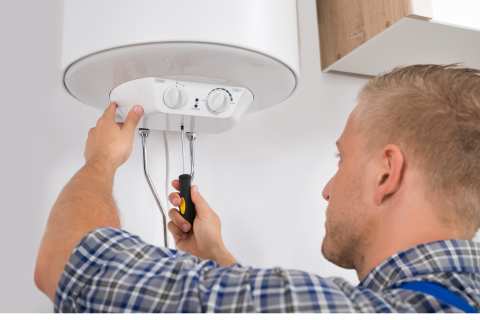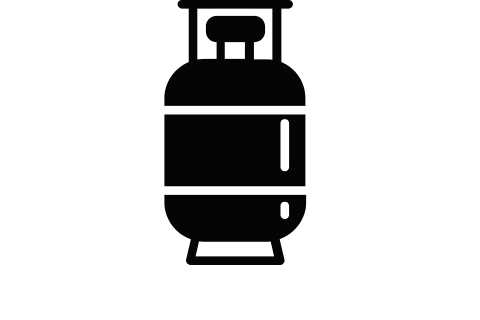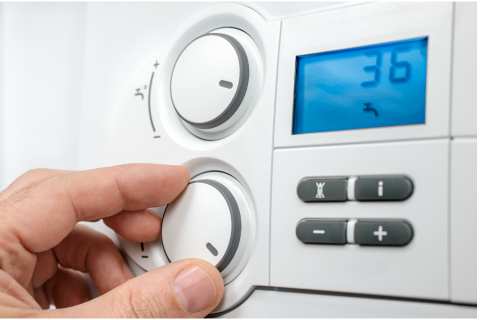Common Immersion Heater Problems & How to Fix Them
If you are lucky enough to have a hot water cylinder with an immersion heater to help make sure yo have a constant supply of hot water, then it is likely that you could potentially encounter some of these problems along the way.
Problems with immersion heaters are common. However, there are usually quick and simple fixes that can get your back up and running in no time.
Here’s all about common immersion heater problems and what to do next!
Get a Boiler Service >How Does an Immersion Heater Work?
Understanding how an immersion heater works is important, especially if you find your immersion heater not working and are looking to find out why.
An immersion heater operates by using electric heating elements to heat water within a hot water cylinder or tank.
Typically, the immersion water heater consists of an upper and lower heating element. When the immersion heater is activated, these elements begin heating the cold water present in the cylinder.
The upper heating element plays a big role in the initial heating process. As the water heats up, it undergoes a natural stratification, with hotter water rising to the top near the upper element and cooler water settling at the bottom.
Get new boiler quotes online >
Just like a kettle…
The immersion water heater continues operating until it reaches the water temperature set on the thermostat.
Once the desired temperature is reached, the system maintains it by heating the water to compensate for heat loss. When a hot water tap is opened, the heated water is drawn from the top of the cylinder, ensuring a constant supply of warm water.
The thermostat regulates the immersion heater, preventing overheating and contributing to energy efficiency. Overall, the immersion heater’s mechanism provides a reliable and consistent source of hot water for various household needs.
Get a Boiler Service >Immersion heater switch light not working?
If the indicator light on your immersion heater switch is not functioning, it signals potential electrical issues or a malfunction within the switch itself.
Start by checking the power supply, making sure that the circuit breaker is not tripped, and inspecting the switch for visible damage or loose connections.
Verify the integrity of the wiring connected to the switch and test the light bulb for possible burnout. If these steps don’t resolve the issue, consider using a multi meter to assess the switch’s electrical continuity.
Seeking professional assistance from a qualified Gas engineer may be necessary for a more thorough inspection and resolution.
Always prioritise safety and, if unsure, consult with experts to address the problem effectively. Regular servicing and prompt repairs are essential to achieve the best performance and safety of the immersion heater system.
Why is my immersion heater not heating water enough?
Heating in an immersion heater can be attributed to various factors. Common causes include a faulty heating element, thermostat issues affecting temperature regulation, sediment build-up at the tank’s bottom, incorrect thermostat settings, water supply inconsistencies, voltage problems, aging of the heater, insufficient insulation leading to heat loss, and the presence of air in the system hindering proper heating.

Additionally, a tripped circuit breaker or fluctuations in electrical supply may impact the heater’s performance.
To address these issues, it involves checking and rectifying elements like the heating element, thermostat, and tank conditions, as well as ensuring a stable electrical connection.
If troubleshooting steps prove ineffective, seeking professional assistance for a comprehensive inspection is recommended to restore the immersion heater’s optimal heating capabilities. Regular servicing practices contribute to sustained efficiency and performance.
Get a Boiler Service >How long do immersion heaters last?
You may find yourself wondering, how long does an immersion heater last? The lifespan of an immersion heater can vary based on factors such as usage, water quality, and servicing. On average, a well looked after immersion heater can last between 10 to 15 years.
Regular servicing, including flushing the tank to prevent sediment build up, checking and replacing heating elements as needed, and ensuring proper insulation, can contribute to prolonging the heater’s lifespan.
However, factors like hard water, voltage fluctuations, or manufacturing quality may impact longevity. Monitoring the heater’s performance, addressing issues promptly, and considering replacement if efficiency declines in your immersion heater.
Regular professional inspections can also help assess the heater’s condition and determine if replacement is necessary.
How much does it cost to replace a cylinder immersion heater?
Budget considerations are essential. This section provides an overview of the costs associated with replacing a cylinder immersion heater, including factors that might affect the overall expense.
Get a Boiler Service >How to reset an immersion heater?
Here is a step-by-step guide on how to reset immersion an heater.

Before attempting to reset the immersion heater, make sure that the power supply is switched off. Locate the dedicated circuit breaker or immersion heater switch in your electrical panel and turn it off, sometimes an immersion heater reset can be the most simple, yet effective fix.
Identify the Reset Button
Most immersion heaters have a reset button located on the thermostat or heater itself. The immersion heater reset button is usually a red or black button that may be recessed.
Wait for a Few Minutes
After turning off the power, wait for at least 5 to 10 minutes. This waiting period allows the system to reset and cool down.
Press the Reset Button
Once the waiting period is over, locate the reset button and firmly press it. You might need a pen or a small tool to reach a recessed reset button.
Turn On the Power
After successfully resetting the immersion heater, go back to the electrical panel and turn the power supply back on. Flip the circuit breaker or switch to the “on” position.
Monitor the Heater
Keep a close eye on the immersion heater to ensure that it starts functioning again. Listen for any unusual noises or vibrations and check for signs of heat production.
Test the Hot Water Supply
Turn on a hot water tap in your home to check if the water is heating up properly. It might take a bit of time for the water to reach the desired temperature, so be patient.
Repeat if Necessary
In some cases, a single reset might not be sufficient. If the issue persists, you can repeat the process a couple of times. If the problem continues, further investigation or professional assistance may be required.
Always prioritise safety. If you’re uncertain about any step, or if the immersion heater continues to malfunction, it’s advisable to consult a qualified technician, DIY repairs are not recommended.
If the reset button keeps tripping frequently, it could indicate an underlying issue. Professional inspection is recommended in such cases.
By following these simple steps, you can often resolve minor problems with your immersion heater and enjoy a consistent supply of hot water.
Remember, if the problem persists or if you’re uncomfortable performing the reset, getting help from a qualified Gas Safe engineer is always the best option.
Get a Boiler Service >The process of the hot and cold water mixing in the cylinder
The process of hot and cold water mixing in the cylinder for an immersion heater involves the entry of cold water into the cylinder, where the immersion heater’s heating elements, particularly the upper one, are activated.
These elements heat the water, creating a natural temperature stratification inside the cylinder.
As the water warms, it circulates, with hot water rising to the top and colder water settling at the bottom. The immersion heater operates until the thermostat-regulated temperature is achieved.
When a hot water tap is opened, the drawn water comes from the top of the cylinder, while cold water simultaneously replaces it at the bottom, maintaining a continuous supply of hot water.
This intricate process ensures a balanced and efficient heating system, contributing to a reliable hot water supply in homes.
Why do I have cylinder immersion heaters?
The presence of a cylinder in immersion heaters serves a big role in hot water systems. The cylinder, often called a hot water cylinder or tank, functions as a storage unit for the heated water produced by the immersion heater.

This design allows for the accumulation of a big volume of hot water, ensuring a consistent and readily available supply for various household needs.
The immersion heater heats the water within the cylinder, and the cylinder’s insulation helps retain the warmth, minimising energy loss.
This setup is a big advantage for homes where hot water demand fluctuates throughout the day, as it enables the system to store and deliver heated water efficiently.
Additionally, the cylinder allows for a balanced distribution of hot water and facilitates the natural stratification of temperature, contributing to the overall effectiveness of the immersion heater in providing a reliable hot water source.
Get a Boiler Service >How do you know if the immersion heater is working?
To determine if an immersion heater is functioning, conduct a visual inspection for signs of operation, such as a glow from the heating element.
Listen for humming or buzzing sounds. Check the temperature of the hot water output from a tap, ensuring it aligns with the thermostat setting.
Verify that the circuit breaker associated with the immersion heater is not tripped, and confirm the immersion heater switch is turned on, checking for indicator lights if applicable.
Consistent hot water supply over time indicates proper functionality, while inconsistencies may suggest issues.
If issues continue, pressing reset buttons and seeking professional inspection can provide further insights. Regular monitoring and swift action in response to irregularities contribute to the efficient operation of the immersion heater.
What Servicing Is Required For Immersion Heaters?
proper servicing of immersion heaters is needed to maintain their efficiency and longevity. Regular tasks include flushing the tank to remove sediment build up, inspecting and replacing heating elements, checking for signs of corrosion, and replacing faulty thermostats for accurate temperature control.
Immersion heater switches should be regularly inspected for proper functioning and safety considerations, addressing issues promptly.
There are options to get boiler cover, giving you a further layer of protection. In most boiler cover plans, an annual boiler service is included, leading to an increased lifespan for your immersion heating system.
Routine professional check-ups provide a thorough assessment of the system’s health. Additionally, testing and resetting procedures, insulating the tank, and monitoring energy efficiency contribute for the best performance and stop immersion heater faults from accuring.
Replacing a Faulty Thermostat
Get a Boiler Service >The thermostat holds great importance in the functionality and efficiency of an immersion heater. Serving as the control centre, the thermostat regulates the temperature of the water within the hot water cylinder, ensuring it stays within the desired range.
The installation cost of a thermostat is relatively modest compared to the potential benefits. While installation expenses may vary based on factors such as the type of thermostat, labour costs, and the specific model of the immersion heater, the investment is generally considered the main one.
Identifying a faulty thermostat in an immersion heater involves paying attention to key indicators. Inconsistent water temperatures, ranging from excessively hot to lukewarm or a complete lack of hot water despite the immersion heater operating, may signal thermostat issues.

Unusual clicking sounds, visible damage or corrosion, and fluctuating operation of the heating elements are additional signs to watch for. If the circuit breaker associated with the immersion heater trips frequently, it could be linked to thermostat malfunction.
Age is also a factor, as older systems may experience wear and tear, leading to thermostat failure. Prompt investigation and, if necessary, professional assistance are recommended to address thermostat issues, ensuring an efficient and safe hot water supply.
Flushing the Tank to Remove Sediment
Flushing the tank of an immersion heater is a vital servicing task to eliminate scale buildup and maintain optimal performance.
Over time, minerals and debris in the water supply can settle at the bottom of the tank, forming sediment that insulates the heating element.
To flush the tank, start by turning off the power supply to the heater to ensure safety. Connect a hose to the drain valve located at the tank’s bottom and place the other end in a suitable drainage area. Open the drain valve and allow the water to flow out, carrying sediment with it.
Repeat this process until the water runs clear, indicating the removal of accumulated sediment.
Regular flushing, recommended at least annually, helps prevent efficiency issues, reduces energy consumption, and extends the lifespan of the immersion heater by maintaining a clean and functional heating system.
Checking for Signs of Corrosion
Checking for signs of corrosion on an immersion heater is an aspect of servicing to ensure its longevity and efficiency. Start by visually inspecting the heater’s exterior for any visible rust, especially on the casing or connections. Additionally, examine the heating elements and the anode rod, if present, as these are prone to corrosion.
If there are signs of rust or corrosion on these components, it may indicate an issue. Inside the hot water tank, check for discolouration or rust-coloured water, which could suggest corrosion within.
Pay attention to any unusual smells or tastes in the hot water, as these can be indicators of corrosion affecting water quality.
Get a Boiler Service >FAQ’S
Can Limescale buildup be the reason my immersion heater not working?
Limescale buildup can significantly impact the functionality of an immersion heater. When hard water, which contains high levels of minerals like calcium and magnesium, is heated, these minerals can precipitate and form limescale deposits on the heating elements.
This buildup creates an insulating layer around the heating elements, acting as a barrier that reduces the efficiency of heat transfer.
As a result, the immersion heater requires more energy to heat the water, leading to increased energy consumption and higher utility bills. Additionally, limescale can hinder the even distribution of heat, causing localised hotspots on the heating elements.
Over time, this uneven heating can lead to damage, decreased lifespan of the immersion heater, and a potential increase in maintenance costs. Regular descaling or maintenance to remove limescale buildup is essential for preserving the efficiency and longevity of an immersion heater.
Why do I have cylinder immersion heaters?
Immersion heaters are paired with a cylinder, commonly known as a hot water cylinder or tank, to fulfill the vital role of storing and providing a consistent supply of heated water.
The cylinder acts as a reservoir where cold water from the mains supply or storage tank enters and gets heated by the immersion heater’s elements.
The immersion heater, typically equipped with upper and lower heating elements, warms the water within the cylinder to the desired temperature. The cylinder’s insulation ensures minimal heat loss, optimising energy efficiency.
What to do if there is no hot water from immersion heater?
If you’re experiencing no water coming from your immersion heater, there could be several potential causes. First, check to ensure that the power supply to the immersion heater is active. If the power is on and there’s still no hot water, it could indicate a malfunction in the heating element or thermostat.
Additionally, there might be issues with the water supply or the plumbing connected to the immersion heater. It’s also possible that there’s a blockage or a leak in the system preventing water flow.
Can a faulty thermostat effect the immersion heaters performance?
Yes, a faulty thermostat can significantly impact the performance of an immersion heater. The thermostat plays a huge role in regulating the temperature of the water within the hot water cylinder.
If the external thermostat malfunctions, it may inaccurately control the heating elements, leading to issues such as overheating or inadequate heating.
In the case of overheating, the immersion heater may continuously heat the water beyond the set temperature, posing safety risks and potentially damaging the heating elements.